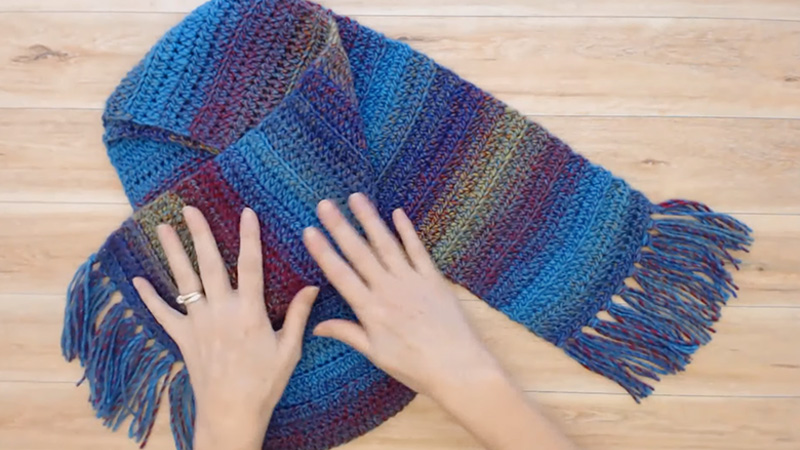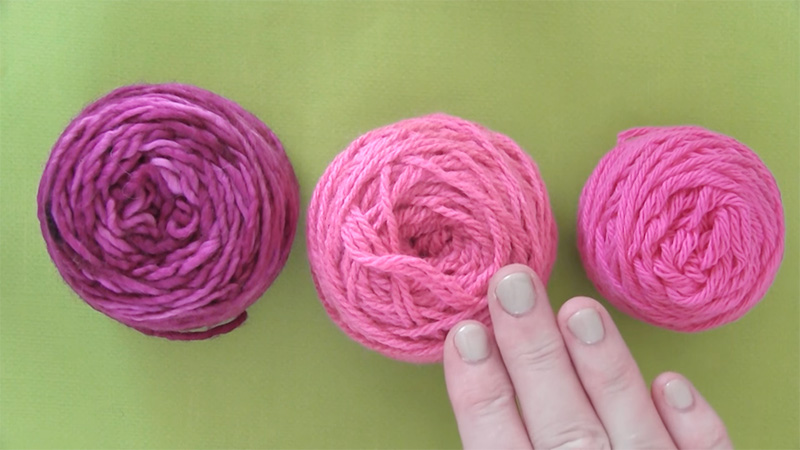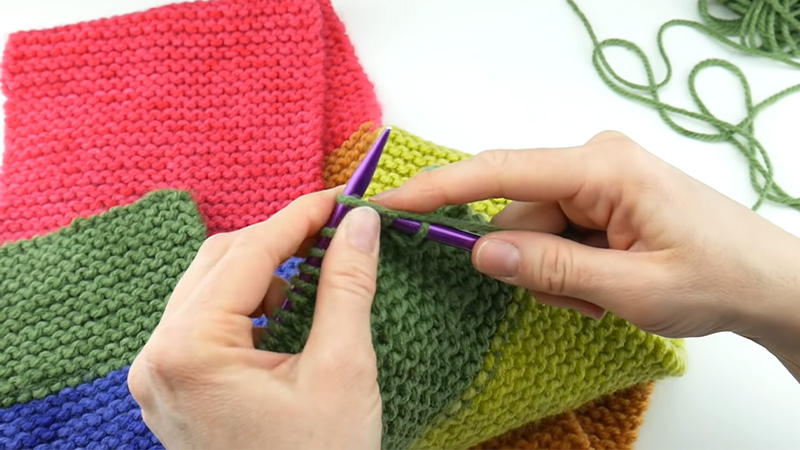Learning how to knit a scarf is like embarking on a cozy and creative journey in the world of yarn and needles. For beginners, it’s the perfect gateway project to discover the joys of knitting.
Scarves not only offer warmth and style but also provide an excellent canvas for practicing fundamental knitting techniques.
In this guide, we’ll unravel the art of knitting a scarf for beginners, exploring various methods and tips to ensure your knitting experience is enjoyable and rewarding.
Whether you’re picking up knitting needles for the first time or honing your skills, you’ll find valuable insights to help you craft beautiful scarves that reflect your unique style.
So, gather your materials, take a deep breath, and let’s dive into the wonderful world of knitting as we embark on the journey of creating scarves that are not only practical but also infused with your creativity and warmth.

How To Knit A Scarf For Beginners?
Learning how to knit a scarf is a fantastic project for beginners. Scarves are not only fashionable but also practical, making them an excellent starting point for aspiring knitters.
Here are some simple methods to knit a scarf:
Garter Stitch Scarf
The garter stitch scarf is perfect for absolute beginners. To create it, you only need to know the basic knit stitch. Simply cast on the desired number of stitches, then knit every row until your scarf reaches your desired length. It’s an ideal project for practicing tension and stitch consistency.
Stockinette Stitch Scarf
The stockinette stitch is another fundamental knitting stitch. To make a stockinette stitch scarf, cast on stitches and alternate between knitting one row and purling the next.
This creates a smooth, flat fabric with a “V” pattern on one side and a bumpy texture on the reverse.
Ribbed Scarf
Ribbing is a versatile pattern that creates a textured, stretchy fabric. To knit a ribbed scarf, alternate between knitting and purling stitches within the same row. For example, you can knit 2, purl 2, or knit 1, purl 1 to create different ribbing patterns.
Seed Stitch Scarf
The seed stitch is a reversible pattern that gives your scarf a lovely texture. To knit a seed stitch scarf, alternate between knitting and purling within the same row, but change the order on each subsequent row (purl the knits and knit the purls).
Basketweave Scarf
Basketweave is an attractive textured pattern that resembles woven fabric. It involves blocks of knit and purl stitches. You can create a simple basketweave pattern by alternating between knitting and purling stitches in blocks of 4×4 or 5×5, for instance.
Striped Scarf
Add color to your scarf by knitting stripes. You can use different yarn colors to create bold stripes or stick to a single color with alternating stripes of knit and purl stitches for added texture.
Lace Stitch Scarf
If you’re feeling adventurous, try knitting a lace-stitch scarf. Lace patterns incorporate yarn over and decrease to create delicate and openwork designs. Start with a simple lace pattern to build your confidence before tackling more intricate designs.
These seven methods offer a range of scarf patterns suitable for beginners. Whether you prefer the simplicity of garter stitch or want to experiment with textured patterns and color changes, knitting a scarf is a rewarding and enjoyable project for knitters of all levels.
Tips For Choosing Yarn To Knit A Scarf For Beginners

Choosing the right yarn for your beginner knitting project, like a scarf, is crucial to ensure a positive knitting experience and a beautiful finished product.
Here are the tips to help you select the perfect yarn:
Start with Medium Weight Yarn (Worsted)
For your first scarf, opt for a medium-weight yarn, commonly known as worsted weight (usually labeled as “4” on yarn labels). It’s easy to work with and offers a good balance of warmth and drape, making it suitable for a wide range of scarf patterns.
Select Soft and Comfortable Yarn
As a beginner, choose a yarn that feels soft and comfortable against your skin. Acrylic, cotton, and wool blends are excellent options. Avoid scratchy or overly textured yarns that may be challenging to work with, especially if you have sensitive skin.
Consider Solid or Semi-Solid Colors
Solid or semi-solid colors are ideal for your first scarf project. They allow you to focus on your knitting without the distraction of complex color changes. Solid colors also showcase the stitch patterns more clearly.
Check the Yarn Label for Care Instructions
Always check the yarn label for care instructions. Beginners may prefer yarn that is machine washable and easy to care for, as this minimizes the stress of maintaining your finished scarf.
Stick to Lighter Shades
Lighter-colored yarns, such as pastels or neutrals, are generally easier to work with for beginners. They make it easier to see your stitches and any potential mistakes. Save vibrant and dark colors for more advanced projects.
Choose a Yarn Within Your Budget
Yarn comes in a wide range of price points, so choose one that fits your budget. Remember that a single skein or two is typically sufficient for a scarf, making it an affordable project for beginners.
Ask for Recommendations
If you’re unsure about yarn choices, don’t hesitate to ask for recommendations from experienced knitters, yarn store staff, or online knitting communities. They can provide valuable insights and suggest yarns that are beginner-friendly.
By following these tips, you can select the perfect yarn for your beginner scarf project. Remember that the most important thing is to choose a yarn that you enjoy working with, and that complements your chosen knitting pattern.
As you gain experience, you can explore a wider variety of yarns and experiment with different textures and colors in your knitting projects.
Tips For Choosing Needles To Knit A Scarf For Beginners

Selecting the right knitting needles for your scarf project as a beginner is essential to ensure a smooth and enjoyable knitting experience. Here are the tips to help you choose the perfect needles:
Start with Straight Needles
For a beginner’s scarf, begin with straight knitting needles. They are the most common type and are excellent for learning basic knitting techniques, such as casting on, knitting, and purling.
Straight needles are available in various lengths, so choose ones that are comfortable for you.
Choose the Right Needle Material
Knitting needles come in various materials, including wood, metal, and plastic. Wooden needles provide a warm and tactile feel, making them comfortable for extended use.
Metal needles are durable and smooth, facilitating quick knitting. Experiment with different materials to see which you prefer.
Opt for Larger Needle Sizes
Select larger needle sizes, typically between US 8 and US 10 (5mm to 6mm), for your beginner scarf. Larger needles create looser, more forgiving stitches, making it easier to see your work and avoid tight tension, which can be common for beginners.
Check Needle Length
Needle length matters when knitting a scarf. Longer needles can accommodate more stitches, making them suitable for wider scarves or projects with a substantial stitch count. Shorter needles are ideal for narrower scarves.
Consider Circular Needles for Versatility
While straight needles are traditional for scarves, circular needles can be a versatile choice for beginners. They allow you to knit a wider scarf or try knitting in the round for a seamless, tube-style scarf. Circular needles can also reduce the strain on your wrists.
Ask for Advice at a Yarn Store
If you’re uncertain about needle selection, visit a local yarn store and seek advice from the staff. They can recommend suitable needles based on your yarn choice and project specifications. They may even allow you to try different needles before making a decision.
Try Interchangeable Needle Sets
Interchangeable knitting needle sets are a valuable investment for the long term. These sets come with multiple needle tips and cable lengths that can be combined to accommodate various projects.
As a beginner, you may find these sets convenient as you explore different knitting projects beyond scarves.
By following these tips, you can confidently select knitting needles that match your skill level and project requirements.
Remember that as you gain experience, you may develop preferences for specific needle materials and styles, but starting with the right needles will set you up for success in your knitting journey.
FAQs
What basic knitting skills do I need to knit a scarf as a beginner?
To knit a scarf, you’ll need to learn the two fundamental knitting stitches: the knit stitch and the purl stitch. These stitches form the basis of most knitting patterns. You’ll also need to know how to cast on stitches to start your project and how to bind off to finish it.
How do I choose the right yarn for my beginner scarf project?
For beginners, it’s best to select a medium-weight yarn (worsted weight) in a solid or semi-solid color. Look for soft and comfortable yarns made of materials like acrylic, cotton, or wool blends.
What are the recommended needle sizes for a beginner’s scarf?
Larger needle sizes, typically between US 8 and US 10 (5mm to 6mm), are recommended for beginners. These larger needles create looser stitches, making it easier to see your work and avoid tight tension.
How long should a beginner’s scarf be, and how many stitches should I cast on?
A typical scarf length ranges from 60 to 70 inches (150 to 178 cm). The number of stitches to cast depends on your yarn, needle size, and desired width. As a starting point, consider casting on 20 to 30 stitches and adjusting based on your gauge and preferences.
What are some easy stitch patterns for a beginner’s scarf?
As a beginner, you can start with simple stitch patterns like the garter stitch (all knit stitches on every row) or the stockinette stitch (alternating rows of knit and purl stitches). These patterns create classic, attractive scarves with minimal complexity.
Conclusion
As we conclude our exploration of how to knit a scarf for beginners, you’re now equipped with the skills and knowledge to embark on your knitting journey with confidence and enthusiasm.
Scarf knitting offers a delightful blend of simplicity and creativity, making it the perfect starting point for newcomers to the craft.
Remember that every stitch you make is a step closer to completing a cozy and stylish accessory that you can proudly wear or share as a thoughtful gift.
The skills you’ve learned here, from casting on to binding off, will serve as the foundation for tackling more complex knitting projects in the future.
So, pick up those needles, choose your favorite yarn, and let your imagination run wild as you create scarves that not only keep you warm but also showcase your unique style and personality.
Leave a Reply